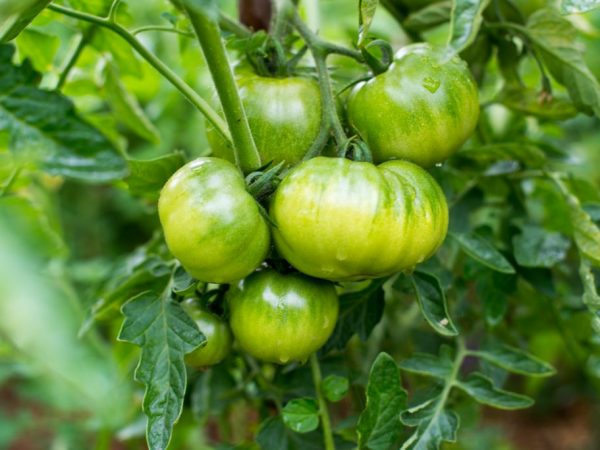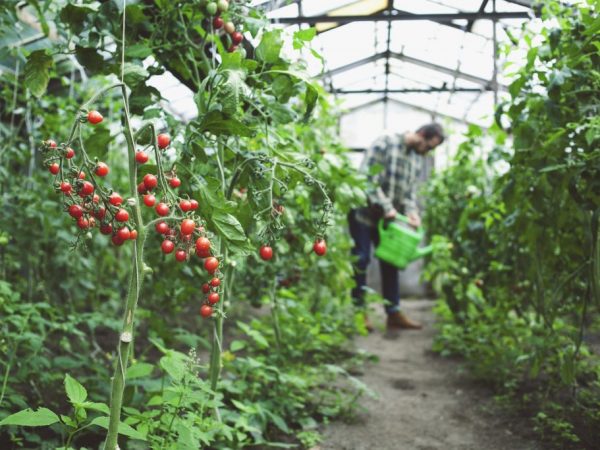How to feed tomatoes during fruiting
Top dressing of tomatoes during the fruiting period is a prerequisite for growing vegetables. It is important to apply fertilizers not only in sufficient volume, but also taking into account the needs for certain elements at different stages of plant development. Top dressing is also necessary because tomatoes are very demanding on the quality of the soil. Each plant tries to take all the elements necessary for growth and development, thereby impoverishing it. To ensure high rates of growth and ripening of fruits, it is necessary to pay attention to the correct preparation of the nutrient mixture.

Top dressing of tomatoes during fruiting
When to feed?
It should be borne in mind that too frequent feeding can damage the tomatoes. Therefore, it is recommended to carry out this procedure during the following periods of the plant's life:
- After planting seedlings in the ground.
- Just before flowering.
- When the first ovaries appear.
- During fruiting.
For the full ripening of the fruits, when the tomatoes have not yet poured, the third and fourth feeding are most important. The third feeding contributes to the formation of full-fledged fruits. It is carried out during the period of active flowering and ovary formation. The next top dressing, carried out during the fruiting period, is aimed at increasing the yield of the bush. In conditions of poor soil or with prolonged rains, tomatoes need more frequent feeding. For greenhouse plants, this procedure should be done less frequently to avoid excessive moisture. During the ripening of fruits, the amount of nitrogen fertilizers should be reduced - an excess of nitrogen will provoke the formation of green mass, which will take away all the nutrients.
Types of dressings
- Mineral.
- Organic.
- Complex organomineral.
- Based on humates.
First of all, tomatoes need certain elements that directly affect the yield and development of the plant as a whole. These elements include nitrogen, phosphorus and potassium - they play a primary role. The presence of calcium, zinc, copper, magnesium and iron in the soil is also important.
Top dressing based on mineral salts
Mineral fertilizers contain various chemical elements necessary for plants at different periods of growth and development. These are mainly sodium, phosphorus and potassium (also referred to as NPK). It is convenient to use ready-made mineral fertilizers such as Kemira Universal or Solution. They can be purchased at specialist gardening stores. Such fertilizers help to improve the taste and increase the yield of tomatoes. However, if necessary, fertilizers can be made independently. During ripening, tomatoes are most in need of potassium, so top dressing must necessarily contain this element.

The feeding solution should be prepared correctly
Even when using compound fertilizers, it is recommended to add potassium sulfate in a volume of 20 grams per 10 liters.The lack of potassium is indicated by the appearance of red specks on young leaves, which merge into solid brown spots at the edges of the leaf. Soon the leaves fall off, and the fruits become unevenly colored. When the first signs of potassium deficiency appear, you need to feed with 1% potassium sulfate solution. Poorly developed fruits and bluish tinge of leaves indicate a lack of phosphorus. To prepare a phosphorus-containing fertilizer, you should dissolve superphosphate in boiling water in a ratio of 35 grams of fertilizer (about 2 tablespoons) per liter of water.
To completely dissolve the superphosphate, the resulting solution must be infused for at least 8 hours, after which it is diluted in 10 liters of water and applied at the rate of 0.5 liters per tomato bush. Lack of calcium during the fruiting period is characterized by the appearance of apical rot, in which the top of the fruit darkens and begins to dry out. In this case, it is recommended to spray the plants with a special solution, at the rate of 20 grams of calcium nitrate per 10 liters of water.
Organic feed
To replenish potassium, you can also use ordinary wood ash; you need to feed it with the loosened soil under the bushes. However, an ash solution with the addition of iodine and boric acid will be more effective. To prepare it you will need:
- Ash 1.5-2 l.
- Boric acid 10 g.
- Alcohol solution of iodine 10-15 ml.
First, the ash is mixed with 5 liters of boiling water. After the mixture has cooled down, add water to it so that the final volume of the solution is 10 liters. Then iodine and boric acid are added to the solution (for better dissolution, boric acid is preliminarily diluted in a small amount of warm water). In a day, the fertilizer solution will be ready for use.
Before using the solution, a liter of the mixture is diluted in 10 liters of water. Each individual bush requires 1 liter of fertilizer: greenhouse plants - once every 2 weeks, and for tomatoes grown in the open field - once a week.
The active content of potassium and other trace elements in the ash significantly accelerates the fruiting process, iodine protects plants from fungal and bacterial diseases, and boron promotes the setting of new fruits. The use of potassium permanganate (potassium permanganate) instead of iodine has a positive effect on the formation of fruits. Experienced gardeners recommend alternating fertilizing with manganese and iodine for more even plant development.
Top dressing based on organic-mineral mixtures

Top dressing will help the fruit develop faster.
During the period of active formation and development of fruits, good results are obtained by using fertilizers from a mixture of organic and mineral fertilizers. For the manufacture of fertilizers, you must:
- Mullein 1 l.
- Complex mineral fertilizer 16-18 g.
- Copper sulfate or manganese 1 g.
As a mineral fertilizer, you can use Kemira Universal or Solution. All ingredients are dissolved in 10 liters of water. The resulting mixture is watered tomatoes at the rate of 1.5 liters per one bush of determinant varieties or 2.5 liters per bush of tall varieties.
Top dressing with the addition of humates
Humic acids are the basis of biological humus (humus). Their constituent sodium and potassium salts, also called humates, have many beneficial properties. Humates activate metabolic processes, increase yields, bind sandy soils, accelerate soil heating and retain moisture. Feeding with fertilizers with humates should be combined with other fertilizers.
Humates are used on any soil other than black soil, since it already contains a sufficient amount of humus. Humates are added to the working solution according to the manufacturer's instructions on the package. Usually added to one bucket of liquid (10 liters of water) 5-7 grams of dry humate (1 teaspoon). If the humates are liquid, then it is poured at the rate of 25 milliliters of the product per standard bucket.For each bush, 0.5 liters of such a solution is enough.
Useful tips for gardeners
- In order to fertilize tomatoes with house manure, it should be remembered that it already contains a certain amount of minerals (such as phosphorus and nitrogen). Therefore, it is necessary to strictly observe the dosage of mineral fertilizers in order to prevent their excess in the soil. Otherwise, it may affect the development of the fruit.
- Tomato belongs to the so-called chlorophobes - it reacts very sharply to the increased content of chlorine and its salts in the soil. Therefore, fertilizing tomatoes with potassium chloride is extremely undesirable, especially in greenhouse conditions.
- In addition to fertilizing, experienced gardeners recommend a root pulling method. To do this, each bush is slightly pulled on the lower part of the stem to cut off some of the small roots. Then the plant is watered and spud. As a result of stress, tomatoes channel all the nutrients from the soil to fruit development.
Tomato is a rather capricious plant that makes high demands on the quality of the soil and needs timely application of various fertilizers. At first glance, fertilizing a tomato, especially during the fruiting period, is a laborious and painstaking process. However, with proper care, the plant will give a bountiful and tasty harvest at the right time.


